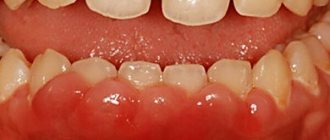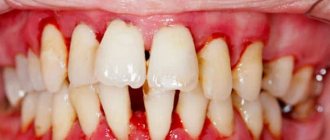To the reference book Hypertrophy of the palatine tonsils is characterized by a sore throat and difficulty breathing.
Author:
- Oganesyan Tigran Sergeevich
ENT pathology expert
5.00 (Votes: 1)
Hypertrophy of the palatine tonsils is an enlargement of the tonsils without signs of an inflammatory process. Most common in children.
Clinical picture
Patients with hypertrophy complain of:
- changes in diction and pain that increases with swallowing;
- difficulty in respiratory function (when, along with the palatine tonsils, the nasopharyngeal tonsil enlarges).
As a result of breathing problems, sleep problems may occur in the form of frequent awakenings and snoring. The patient also suffers from coughing at night. With the development of hypoxia, neuropsychic disorders are observed.
1.General information
Hypertrophy means an abnormal or pathological increase in the size of an organ, structure, or tissue. This concept should be clearly distinguished from terms (and the phenomena they denote) such as hyperplasia, tumor or edema.
Hyperplasia, for example, is the rapid growth of tissue due to a hormone-mediated increase in the number of healthy cells typical of a given tissue; the tumor process is characterized by a local increase in the number of cells with certain abnormalities and, finally, edema is an excessive accumulation of fluid in the cells or intercellular space.
In contrast to the above, hypertrophy is an increase not in the number of cells, but in their size - with a relatively normal quantity for a given organ - and is considered as a response to certain factors, conditions, influences.
Further, the tonsils (medical lat. “tonsilla”, incorrectly “tonsils”) are a group of glandular formations from lymphoid tissue, collectively making up the so-called. lymphadenoid pharyngeal ring and perform mainly the role of an immune barrier at the entrance to the respiratory and digestive tracts, in close proximity to the brain and sensory organs - in an area where many blood vessels, nerve tracts, lymph nodes and ducts are concentrated. In other words, the presence of the pharyngeal ring here as an outpost of the immune system is completely understandable; however, the tonsils also perform other functions that have not yet been studied enough or are completely unknown.
The most significant is a pair of relatively large palatine tonsils located on either side of the entrance to the laryngopharynx.
Tonsil hypertrophy is common in the general population with an estimated incidence of 5-10 to 40 percent. The vast majority of primary patients with this diagnosis are children and, less often, adolescents. Hypertrophic enlargement of the tonsils, which develops in adulthood, is sporadically rare.
A must read! Help with treatment and hospitalization!
Diagnostics
Diagnosis of hypertrophied tonsils is not difficult. The data from pharyngoscopy are used as a basis. The pathology has several degrees of severity, taking into account the stage of development. The extreme stage involves the contact of the tonsils with each other.
Despite the absence of inflammation, it is necessary to differentiate hypertrophy from chronic tonsillitis and tumors. The latter are represented by lymphosarcoma and lymphogranulomatosis, the characteristic features of which are asymmetry, increased tissue density and metastases.
According to indications, blood tests and biopsies are also prescribed, the results of which help clarify the diagnosis. The fluctuation method used during palpation helps to distinguish hypertrophy from an abscess or cyst. It is usually combined with a diagnostic puncture, which involves suctioning out the contents.
Causes and course of the disease
Hypertrophic changes in the tonsils are considered as an immunoreactive condition that occurs when the body adapts to changing conditions and mobilizes compensation that has arisen in the lymphoid pharyngeal ring.
This is facilitated by breathing through the mouth, which is caused by hypertrophy of the adenoids, especially in the cold season. If adenoiditis provokes the formation of mucus, which forms in the nasal cavity, infects the palatine tonsils. Hyperplasia (increased cell proliferation) is promoted by infectious diseases and repeated inflammation in the oropharynx and nasal cavity.
Also, this process is influenced by poor living conditions, insufficient nutrition, as well as other factors that can reduce immunity. The size of the tonsils is affected by various disorders in the endocrine system, especially hypofunction (weakening of activity) of the adrenal cortex, exposure to small doses of radiation over a long period of time, hypovitaminosis (lack of vitamins).
The basis for too large an increase in the lymphoid tissue of the tonsils is the active proliferation (proliferation of tissue by cell multiplication) of immature T-lymphocytes and T-helper deficiency, which does not allow the production of full-fledged antibodies. The immunopathological predisposition of the child’s body to lymphatic diathesis, which is caused by hereditary deficiency of the lymphoid system, is influenced. Allergic reactions also influence the formation of hypertrophy of the palatine tonsils.
However, do not forget that hyperplasia is a reversible process. During adolescence, involution (reverse development) of lymphoid tissue occurs.
Hypertrophy of the palatine tonsils is often combined with a pathological enlargement of the entire pharyngeal lymphadenoid ring, especially often with hypertrophy of the pharyngeal tonsil (adenoids). Enlarged palatine tonsils generally have a dense and fairly elastic consistency, but in some cases they are spread out and soft on palpation. The palatine tonsils have no signs of inflammation and are not fused to the palatine arches. They have a developed lower pole and a triangular fold below, and the lacunae have a normal structure.
From a histological point of view, there is a predominance of hyperplasia of lymphoid tissue, in which there is an increase in the area of the follicles and the number of mitoses (indirect division), but plasma cells and macrophages are absent.
Hypertrophy of the palatine tonsils has 3 degrees:
- 1st degree - the palatine tonsils occupy 1/3 of the distance from the arch to the center of the pharynx (if measured along the midline of the pharynx);
- 2nd degree – already 2/3 of the distance mentioned above;
- 3rd degree – the tonsils are almost touching.
A microscopic examination reveals a large number of follicles with very frequent areas of mitosis, which indicates a very high activity of lymphoid tissue.
Friends! Timely and correct treatment will ensure you a speedy recovery!
Treatment
Treatment of enlarged tonsils, leading to sleep and respiratory problems, is only surgical. The operation is called tonsillotomy and involves their partial removal. Under local anesthesia (application anesthesia with lidocaine solution), the doctor cuts off those parts of the tissue that protrude beyond the arches. During the intervention, the patient is in a sitting position.
Classic tonsillotomy requires the use of a Mathieu tonsillotome, which has a special fork to hold the removed tissue. An alternative technique is performed using the Bahon loop. In this case, the separated part of the lymphadenoid tissue is fixed with a Kocher clamp. Our clinic also uses laser techniques for this purpose.
Causes and symptoms of chronic tonsillitis
If general immunity is reduced and/or the body has had to face a powerful infectious attack (for example, a sore throat or infection with herpes viruses), a real battle between the immune system and microbes unfolds in the lacunae of the tonsils. As a result, pus, consisting of dead microbes and cells (purulent-caseous plugs), accumulates in the lacunae. Tonsils clogged with pus stop working as an immune organ , and pathogenic microbes thrive in the purulent contents of the lacunae and multiply. These are the so-called plugs in the tonsils. At this stage of the process, it is enough to wash the tonsils from pus and provide a little help to the immune system, after which the normal function of the tonsils is restored.
Chronic tonsillitis, tonsil in section. 1 – lacunae of the tonsil. 2 – the entrance to the lacuna is blocked by a purulent plug. 3 – entrance to a clean lacuna. On the right - vacuum rinsing of the tonsils - a painless and quick procedure. 8-10 seconds - and the plugs are washed with a disinfecting solution.
Symptoms of chronic tonsillitis:
- Painful sensations in the throat area
- Enlarged lymph nodes
- Bad breath
- Sometimes there are headaches
- Sometimes there is discomfort in the ears
- The waste products of microbes from the tonsils enter the bloodstream , poisoning the body (tonsillogenic intoxication); hence fatigue, pain in muscles and joints, headaches, decreased mood, and even, in some cases, a prolonged increase in body temperature;
- Tonsils become a reservoir of infection , from where it can spread throughout the body and cause inflammatory processes (acne, cystitis, prostatitis, adnexitis, dysbacteriosis, inflammation of the paranasal sinuses, etc.);
- Bad breath - it is caused by organic substances decomposing in the gaps; 4. The tonsils stop working as an immune organ , immunity decreases, and the slightest provocation (hypothermia, overwork, stress) can “finish off” the immune system and open the way for germs.
Hypertrophy of the palatine tonsils in children
Often patients are children aged 5 to 7 years with a complicated history of adenoiditis. In such cases, both tonsillectomy and adenoid removal are performed as part of one intervention. The postoperative stage requires you to follow a diet. Food should be non-irritating, gentle, without adding seasonings. The drink is warm.
You can call an ENT doctor at home or make an appointment with a doctor through the form on the website or by calling the clinic. The doctor will examine the throat and, if hypertrophy is diagnosed, prescribe treatment.
The operation can also be performed on an outpatient basis. In this case, it is necessary to ensure constant monitoring of the patient, which is carried out until the final healing of the wound.
2. Reasons
The connection between hypertrophy of the tonsils and frequent acute respiratory viral infections, tonsillitis, laryngitis and other infectious and inflammatory diseases of the ENT organs has been reliably established. In addition, many sources indicate a higher frequency of such hypertrophies in children with weakened immunity, regardless of the reasons. Finally, a combination of hypertrophied tonsils with adenoids is constantly encountered - a hyperplastic growth of another tonsil, the nasopharyngeal; according to a number of experts, this indicates the commonality of hyperplastic and hypertrophic processes for the entire lymphadenoid ring.
Hence the conclusion is drawn about the compensatory, reactive nature of hypertrophy of the tonsils: in this case, organs that are very often and intensively used and/or cannot cope (with weakened local and general immunity) with their functions increase.
However, the etiopathogenesis of tonsil hypertrophy still remains controversial and is being actively studied by specialists in this field.
Risk factors usually include hypovitaminosis, insufficient and unbalanced nutrition, harmful environmental factors, and endocrine disorders.
Visit our Otolaryngology (ENT) page
Prevention
It is important to live in favorable conditions, keeping the room clean, maintaining a normal level of air humidity and a temperature comfortable for the human body. Nutrition must be correct for the immune system to be active. In autumn and winter, you need to dress according to the weather, not breathe through your mouth, so that the tonsils are not exposed to icy air.
To maintain immunity, hardening, spa treatment, and additional courses of minerals and vitamins may be important. Respiratory and any other diseases must be treated on time so that they do not become chronic.
Why is chronic tonsillitis dangerous?
Chronic tonsillitis is dangerous due to its complications associated with the spread of infection throughout the body. We often see that after treating tonsillitis, our patients are no longer bothered by all sorts of chronic diseases and allergies. The most severe complications of tonsillitis are rheumatism and severe kidney damage - glomerulonephritis. Toxins produced by some microbes tend to damage ligamentous and cartilage tissues, cause inflammation, as well as pain in joints and muscles.
How chronic tonsillitis affects the heart. Heart valve prolapses and heart rhythm disturbances are common findings when examining the heart in patients suffering from chronic tonsillitis. The fact is that the protein of beta-hemolytic streptococcus group A, which often parasitizes the tonsils, is similar to the protein of the connective tissue of the human heart and joints. Therefore, response aggression of the immune system is possible not only against streptococcus, but against one’s own heart and joints.
Chronic tonsillitis and allergies. Sometimes one course of treatment for tonsillitis is enough for allergic rashes, itching and even attacks of bronchial asthma to “magically” go away. The fact is that the long-term presence of an infectious focus in the tonsils not only reduces immunity, but also distorts its reactivity, causing allergic changes.









